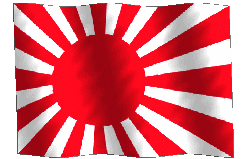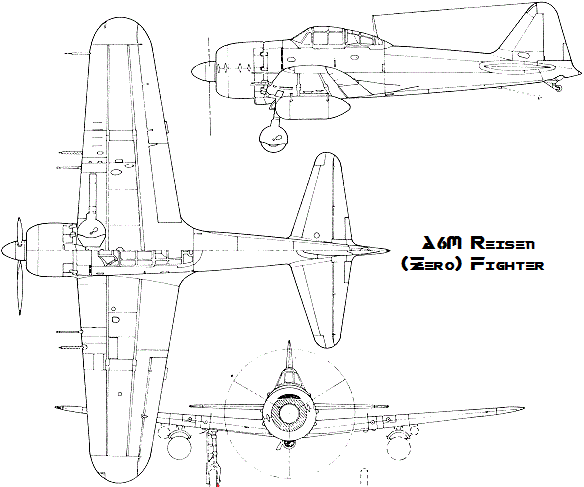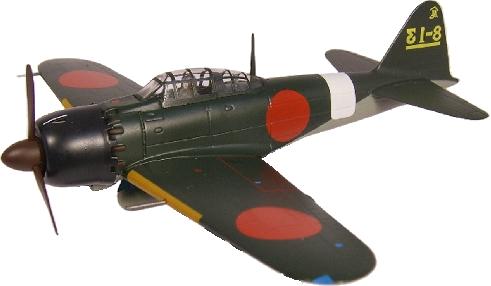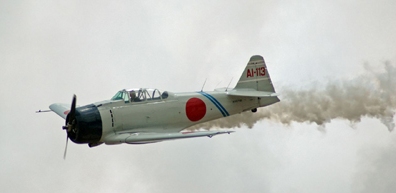
Terran Imperial Japanese Navy. | Reisen (Zero) Fighter. | 
Terran Imperial Japanese Navy. |
|---|
The Japanese, wishing to honor their own history, looked back to the height of Japanese military power- And there sat the A6M Reisen Fighter (aka the Zero Fighter). | | Mitsubishi A6M Reisen (Zero) Fighter Line Drawing. |
|---|
 |  | | | A Reisen (Zero) Fighter With Chitose 468TH Air Control Group. | A Privately Owned Reisen (Pan-Sino-Pacific Racing Group, LLC). |
|---|
The Zero, when first deployed, was possibly the greatest plane EVER to date. Fast, nimble, and well-armed, it made a joke of everything it came across- Until the US Navy came roaring back with the Hellcat Fighter. Even then, the Zero proved to be a FORMIDABLE opponent, until the US Navy's blockade and merchant fleet raiding strangled Japan's critical mat'eri'el pipelines- Especially oil.With everything the Zero had going for it, it still suffered several critical shortcomings- It was unarmored, lightly armed (even by the standards of WWII, it was out-matched ship-for-ship by mid-War), and slow (by War's end). Japanese Weapons Technologists overcame these issues in ingenious ways in the new breed of Zero; First, the wings were re-engineered to be thinner and deeper, giving it more lift and surface area, where rockets could be mounted. Second, the fuselage frame was re-designed with new composites, making it both lighter and stronger. Third, the fuselage skin was replaced outright by a new alloy, making the whole plane armored. Fourth, the 50-caliber machine guns were replaced by a pair of heavy lasers and a pair of PBC's, negating the weight of ammo. Fifth, a new hydro-cell turbo-prop engine was installed, increasing both horsepower AND energy. Finally, grav pods and a Variable Force Field were installed, giving greater lift AND protection.An oddity is ejection seats- The Zero doesn't have them. The canopy must be opened and the pilot must physically climb out to escape. An ejection seat WAS considered, but pilots didn't like it. Also, the survival pack was vastly reduced at pilots insistence (though the same pilots who wanted MORE gear for Guardian and jet fighters were the ones who wanted LESS gear for the Zero). Thinking caps and visor displays were installed, and new zenon-helium-nitrogen based foam inner skin developed, turning the whole plane, if necessary, into a life-raft (several pilots have DELIBRATELY ditched into the ocean on SAR missions, using their craft as de-facto liferafts for stranded mariners). The Zero's wings have 2 hardpoints which can carry 2 rockets, each, 4 SRM's, or 6 mini-missiles. 9 additional mini-missiles can be carried in a launcher in the tail boom.The Japanese Civil Defense Authority, which oversees both JDF and the City Guards and Prefecture Militias, has had nothing but positive feedback on the Zero; In wargames with Los Angeles City Guards (who had only a month before engaged Tiresian Malconts in P-40's), the 10/10 engagement came out with 2 P-38's and a Zero still fighting at "no joy" (one of the P-38's had been "damaged" in the fight, though the Zero bugged out first).The Zero works best when working in tandem with Raider X's and other anti-aircraft batteries.Name: Reisen (AKA the Zero Fighter).Model Type: WarbirdClass: Pursuit/FighterCrew: One; Two-seater models are also available.Passengers: None.MDC By Location: |
Fuselage-
Engine Compartment-
Cockpit Canopy-
Wings (2)- | 100
175
60
100 | Tailerons (2) &; Rudder-
Props (3)-
Landing Struts (3)-
| 70 each
50 each
25 each
|
| Speed and Statistical Data: |
Maximum speed: 400 mph at 16,000 ft.
Cruising speed: 207 mph at optimum altitude.
Range In The Air: 2,000 miles typical, 2,500 miles max; Can not be refueled in the air.
Service Ceiling: 32,810 ft.
Climb Rate: 4,517 ft per min.
Takeoff Length: ABOUT 230 feet, unassisted.
Landing Length: ABOUT 100 feet, unassisted.
Height: 11 ft. 6 in. (3.51 m).
Wingspan:Wings Down: 36 ft. 1 in. (11 m).Wings up: 18 ft. 1/2 in. (5.5 m).
Length: 29 ft. 11 in. (9.12 m).
Weight: 4,136 lb. (1,876 kg) empty. | Operational Weight: 5313 lb typical, 6164 lb max.
Internal Fuel Capacity: 200 gal.
External Fuel Capacity: 100 gal.
Cargo: Pilots supplies only.
Power System: A single Eto-41 Hydro-Cell Turboprop Engine; Output: 1,500 hp at 1,200 KHw
Flight Systems:Primary: Aero-Foil Effect.Secondary: Grav Pods in emergency or for mission-critical VTOL.
Cost and Availability: 50,000credit to authorized purchasers; Only available to Japanese City Guards, Prefecture Militias, and Japanese colonies (generally).
Black Market Cost and Availability: 150-300,000credit; Rarish and not very popular outside Japanese cultures.
|
| Weapons Systems: |
|---|
1. Particle Beam Cannons: The REF-Era PBC-12 particle beam cannon; Set outboard in place of the 20MM cannons that were there.
Purpose: Anti-Aircraft/Armor
MD: 5D10+25 MD per blast per cannon.
Rate of Fire: Per pilots attacks per melee.
Range: 10,000' (nearly 2 miles).
Payload: Effectively unlimited.
2. Laser Cannons: Set inboard in place of the Type 97 7.7 MM machineguns that were there.
Purpose: Anti-Aircraft
MD: Single blast- 3D6 MD. Dual Blast- 6D6 MD.
Rate of Fire: Per pilots attacks per melee.
Range: 10 miles
Payload: Effectively unlimited.
3. Optional M-3 Machineguns: The inboard laser cannons 'can' be swapped out for the venerable .50 caliber M-3 heavy machinegun, but only 100 rounds can be carried, limiting combat time.

| 4. Wing Mounted Weapons Systems: The plane can carry up to 4 pods, though one must be a TM-12 Fuel Pod.A) M-7 Rocket Launcher: 24 2-inch rocket tubes in 12 rows of 4 each.
Each rocket tube has 4 rockets.
Purpose: Heavy Assault
MD: Each rocket does 2D6 MD
Rate of Fire: Volleys of 6 or 12 times pilots attacks per melee.
Range: 12,000 feet
Payload: 96 per pod. Up to 6 pods can be carried.B) TM-11 Torpedo Pod: An ASW torpedo pod. Carries the Mk-82 Airborne Torpedo, essentially a modified version of the Mk-81 Submarine Launched Torpedo. The initial launch is by a nothing so complicated as releasing it from the latches that hold it to the pylon. The on board hydro-cell motor then takes over as soon as the torpedo splashes. Each pod hold 3 Mk-82's.
Purpose: Offensive/Anti-Ship
MD: 4D6 times 10 per torpedo
Blast Radius: 40 feet
Maximum Range: 80 miles
Minimum Range: 5 miles
Rate of Fire: 1 torpedo per pilots attacks per melee.
Payload: Each pod holds 3 Mk-82's.C) TM-12 Fuel Pod: Essentially a modified version of the M-11 Torpedo Pod. In this case, however, it is used as a fuel pod to triple the normal range of the craft.D) C-441 Canister Pod: Basically a hollowed out version of the M-7 pod, used to drop highly sensitive and extensive messages. A nose-mounted device using GPS or laser detection guides the pod to within 1/4 of an inch of the intended target. |
| Features: |
- Radar: Combat grade radar. Range 100 miles, can track up to 200 individual targets. 90% reliability (no reliability against unfriendly stealthed air vehicles, 10% against unfriendly ground vehicles).
- Electronic Counter Measures (ECM): These systems disrupt enemy radar and tracking systems, making it difficult for them to lock onto the ship with weapons. The countermeasures give the Mecha a +3 to dodge, +2 to strike and +1 on initiative in combat.
- ESM: Radar Detector. Passively detects other radars being operated.
- AJP: Active Jamming Pod. Causes-25% to detection but when it is active, other vehicles/bases can detect that it is jamming, and some missiles will home in on jamming signals. Jamming also causes a-4 penalty to all radar guided weapons.
- GPS: Standard tracking device. Ties into the Blue Force Tracker.
- Full range optic sensory suite: Infrared, ultra violet, Magnification, night sight, color filters, thermal imager. Range is about 200 miles for MOST sensors.
- Motion Detector: Activates a loud wailing when an object is coming at the user fast, and a soft ringing if it's coming slowly. Activation ranges must be specified by the pilot.
- Blue Force Tracker: Identifies friend from foe. Overlays the information on both the radar and HUD, ensuring that friendly forces are not accidentally targeted.
- Survival Pack: A pack of simpler emergency survival supplies: Black light, GPS, First aid kit (bandages, gauze, bandage tape, pads, antiseptic/analgesic), plasma torch (for small repairs and starting fires), repair kit (with MDC Repair Spray), sewing kit (a small spool of thread and 5 needles), 7 star flares (250 foot apogee), 100 feet of black or brown parachute cord (150 lbs tensile strength; This is in addition to several hundred feet from their parachute itself), 2-5 days rations, 2 gallons water, water purification kit (good for about 10 gallons), self-inflating lifevest (15# buoyancy). The fuselage double as a survival raft, and the parachute as a pup tent; Neither a liferaft NOR a pup tent are included in the survival kit, nor is a sleeping bag.
- FLIR/SLIR: Forward and Side Looking Infrared. Allows pilot to get visuals on targets at night.
- Video Camera: 20,000 times zoom lens, records all data observed by the unit. 5,000 hours of recording available.
- Variable Tint Cockpit Canopy: Adjusts tinting to light conditions, up to an including a black dot if the sun is directly on the pilots face (only covers eyes).
- Fire Resistance: Fires external to the craft are not felt at all.
- Type-11 wide band radios: Effective 10 mile range, auto encrypt/decrypt. Works on standard radio band wavelengths, so it can still be jammed (if the enemy knows the frequencies).
| - MRA 6 Radios: Allows real time, continuous radio link up with friendly forces in the area via satellite relay over laser radio signals, preventing jamming, and automatically encrypts/decrypts same to prevent eavesdropping.
- Grav Clamps: Grav pods in the wheels of the landing gears allow the planes to adhere to the hulls of Warships and the exteriors of SOME buildings up to a full 90 degrees angle (nose up, down, or to the sides doesn't matter).
- HUD: Displays targeting, airspeed, artificial horizon, and true direction information directly in front of the pilot.
- Visor Display: Anything that can be seen on the HUD can be set in the visor, either as an overlay OR as a pop-up.
- Decoys: Specially modified Mini-Missiles used as decoys; Burning globs of magnesium/aluminum alloy to confuse both radar AND heat sensory systems, as well as creating a lot of smoke to obscure the Mecha. NOTE: Though the modified mini-missiles combine smoke flares, AMC/FDs, and LDP's, they aren't powerful enough for use with Destroids/Guardians/Etc. Reduce effects by 20% against smart missiles (add +20% to rolls for smart missiles).
- Effect:
- 01-50: Enemy missile or missile volley detonates in chaff cloud- Missiles are all destroyed.
- 51-75: Enemy missile or missile volley loses track of real target and veers away in wrong direction (may lock onto another target).
- 76-00: No effect, missile is still on target.
- Also note that the chaff cloud will also blind nearby heat sensors (and optically based sensors at night) for 1 melee. They will suffer the following penalties: Reduce melee attacks/actions, and combat bonuses by half. Also, a cloud of smoke approximately 2503 feet wide and high by about 1 half-mile long.
- Duration: 1D4 melee rounds.
- Rate of Fire: Once per melee.
- Payload: 6 chaff/flares.
- Combat/Targeting Computer: Records all enemy and friendly activity over the course of time; Can replay that activity for the pilot, assign target designation numbers, and track likely damage based on mathematical formulas (i.e. "Right leg red" badly damaged/destroyed, "head green" not damaged, etc). Displays this information as a pop up in the HUD as requested by the pilot.
|
Combat Bonuses from Reisen Fighter Elite:- 4 additional attacks per melee.
- One additional Attack Per melee at levels 3, 6, 9, and 12 with any additional bonuses for the pilot.
- +3 Strike to aircraft, +3 against ground targets.
- +4 Dodge, +3 dodge ground-launched anti-aircraft missiles (in addition to normal +4 dodge).
- +3 Dodge to left/right (with propeller spin/in addition to standard dodge).
- +3 Dive Dodge (in addition to standard dodge).
- +1 Roll.
|